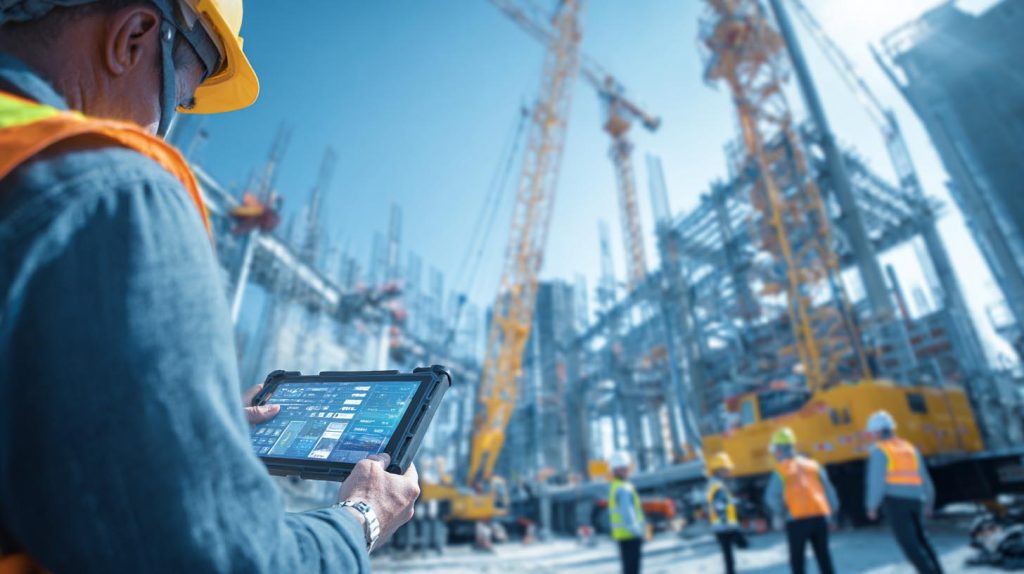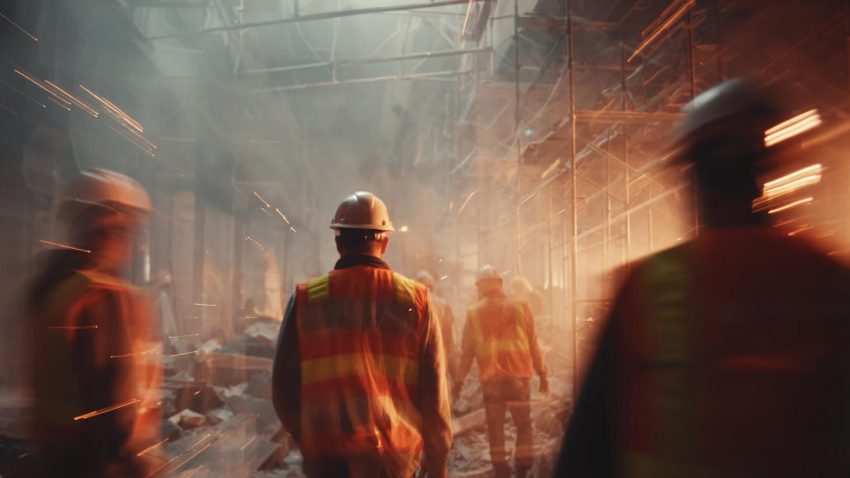Digital Job Hazard Analysis (JHA): What to Include for Construction Safety and Real-Time Audit Readiness.
Table of Contents:

Safety documentation has evolved far beyond clipboards and binders. Today’s construction sites rely on digital Job Hazard Analyses (JHAs) that update in real time, store securely in the cloud, and instantly prove compliance during safety audits. These digital JHAs don’t just check OSHA boxes — they improve how crews communicate, how supervisors verify field activity, and how auditors evaluate jobsite readiness.
For superintendents and project managers, this shift isn’t optional anymore. Owners and safety officers now expect live visibility into documentation. A digital JHA lets teams log hazards, attach photos, and sign off instantly, ensuring every crew member is both informed and accountable. When done right, it streamlines compliance, builds trust, and makes audit preparation virtually effortless.
In this article, we’ll explore what every contractor should include in a digital JHA to enhance jobsite safety, meet OSHA standards, and prepare for real-time audits. You’ll learn how modern tools help identify hazards faster, reduce errors, and ensure all safety documentation stays accurate, consistent, and instantly retrievable — even under audit pressure.
Why Construction Teams Are Moving from Paper to Digital JHAs
Paper-based JHAs served their purpose for decades, but their limitations became clear as projects grew more complex and audit requirements more rigorous. Paper forms are easy to lose, difficult to update, and nearly impossible to verify across multiple trades. Digital JHAs solve these problems by creating a unified platform for data capture, crew participation, and compliance verification — all from a tablet or mobile device.
Digital workflows allow safety managers to view completion status in real time. Supervisors can confirm whether crews have reviewed hazards before work begins, while project leaders can instantly access archived records during an OSHA visit. Automation also reduces administrative burden, ensuring no task, sign-off, or hazard update slips through the cracks.
Top Benefits
- Provides instant visibility into JHA status across all active projects
- Prevents lost paperwork and ensures version accuracy through cloud storage
- Simplifies compliance verification for owners and auditors in real time
Best Practices
- Transition from static PDFs to dynamic, editable forms that sync automatically
- Set digital reminders for overdue reviews or missing signatures
- Link JHA entries to specific trades, activities, or job phases for clarity
Q&A Mini Section
Q: Are digital JHAs OSHA-approved?
A: Yes — OSHA only requires hazard documentation to be accurate and accessible, not on paper.
Q: How does digitizing JHAs save time?
A: Automated updates, reminders, and easy retrieval eliminate manual follow-ups and lost files.
Q: What’s the biggest challenge in going digital?
A: Training crews to adopt new tools — solved through short onboarding sessions and supervisor support.
Digital JHAs empower teams to focus on real safety instead of paperwork — proving readiness long before auditors even arrive.

Key Elements Every Digital JHA Should Include
A well-structured digital JHA mirrors the traditional form but adds layers of interactivity and traceability. The foundation remains the same — task breakdowns, identified hazards, and control measures — but digital systems enhance accuracy, visibility, and accountability. Each section should clearly define who’s responsible, what risks exist, and what controls are enforced.
Beyond standard hazard listings, a complete digital JHA includes timestamps, crew signatures, equipment references, and even photo verification. Each record should link directly to corresponding Pre-Task Plans (PTPs) and Daily Reports, creating a complete safety ecosystem that ties documentation to field activity. When all data is interlinked, audits become smoother, and risk mitigation becomes measurable.
Top Benefits
- Improves traceability through timestamps and linked documentation
- Enhances accountability with digital signatures and audit trails
- Provides contextual clarity by integrating with related project data
Best Practices
- Standardize digital templates company-wide for consistency and compliance
- Include fields for photos, comments, and checklist confirmations
- Require sign-offs before task execution to ensure crew awareness
Q&A Mini Section
Q: What’s the difference between a paper and digital JHA layout?
A: The structure is the same, but digital versions include interactive fields and automation.
Q: Should each crew have its own JHA?
A: Yes — every trade or task requires its own risk-specific documentation.
Q: How detailed should control measures be in digital forms?
A: As specific as possible — each control should clearly describe the required preventive action.
When all critical elements are integrated digitally, JHAs evolve from static checklists into dynamic compliance systems.
How Real-Time JHA Dashboards Improve Audit Readiness
Audit readiness isn’t about scrambling for forms; it’s about proving consistency. Real-time JHA dashboards allow construction managers to view live completion rates, missing approvals, and high-risk tasks across multiple sites — all from one interface. This visibility helps safety teams catch errors before auditors do.
Superintendents can use dashboards to confirm that crews have signed off daily, verify that controls are implemented, and export complete JHA records instantly. With everything stored securely and organized by date or trade, safety audits become a confirmation exercise rather than an investigation. The ability to show live compliance data often impresses owners and regulators, reflecting a proactive safety culture.
Top Benefits
- Enables instant verification of JHA completion and crew sign-offs
- Reduces stress during OSHA or owner inspections with quick record access
- Tracks trends to identify recurring hazards or process gaps
Best Practices
- Use filters to prioritize overdue JHAs or high-risk work areas
- Export weekly reports summarizing safety progress and documentation status
- Conduct pre-audit mock reviews using digital dashboards for accuracy checks
Q&A Mini Section
Q: How can real-time dashboards help during audits?
A: They provide instant evidence of compliance with timestamps, photos, and signatures.
Q: Can auditors access these dashboards directly?
A: Yes, through restricted or read-only guest permissions in most digital systems.
Q: What’s the biggest benefit for superintendents?
A: Clear, real-time visibility into site-wide compliance without chasing paper trails.
Digital dashboards transform audits into streamlined, data-driven evaluations — saving hours while showcasing a strong safety culture.

StruxHub
Experience the power of StruxHub today and witness firsthand how it can revolutionize your construction operations.
Using Crew Collaboration to Strengthen Digital JHA Effectiveness
Digital tools are powerful, but they’re only as effective as the people using them. A great JHA isn’t written behind a desk — it’s built collaboratively with the field team who knows the work best. When superintendents involve crew members in digital JHA reviews, the process becomes far more accurate and relatable. Workers who help identify risks are more likely to follow the safety controls later in the field.
Crew collaboration also boosts engagement. Instead of filling out forms passively, teams can view hazards on tablets, mark up photos, and even comment directly on digital entries. These inputs give supervisors valuable field insights that might not appear in the original plan. And when auditors see that documentation reflects real, worker-driven feedback, it strengthens both compliance credibility and safety culture.
Top Benefits
- Promotes ownership and engagement among field crews
- Captures real-world jobsite hazards directly from the source
- Demonstrates proactive, participatory safety management to auditors
Best Practices
- Hold digital JHA review sessions during morning huddles before work begins
- Encourage foremen to collect team feedback directly within the app
- Rotate crew members responsible for daily JHA verification to build accountability
Q&A Mini Section
Q: How can digital JHAs improve communication between crews and safety managers?
A: Real-time collaboration tools allow workers to share photos or notes directly with supervisors.
Q: Why is crew feedback so valuable for audits?
A: It shows that safety isn’t top-down — it’s practiced and verified at every level.
Q: What’s the best way to motivate crew participation?
A: Recognize teams that maintain consistent, accurate digital JHAs during weekly safety meetings.
When crews take part in the digital JHA process, compliance becomes second nature — and audits become proof of teamwork rather than enforcement.

Automating JHA Reviews and Notifications for Continuous Compliance
Automation is one of the greatest advantages of moving to digital JHAs. Instead of relying on manual reminders or scattered spreadsheets, automated alerts ensure that every review, sign-off, and update happens on schedule. Supervisors receive notifications for overdue forms, while project managers can see exactly which JHAs are complete, pending, or expired.
These automated workflows also ensure that safety documentation never goes stale. When a condition changes — such as new equipment, weather hazards, or task revisions — the system prompts users to update the JHA. Over time, this creates a self-sustaining cycle of continuous compliance, where every project stays aligned with OSHA and owner requirements without adding administrative load.
Top Benefits
- Prevents outdated JHAs through automated reminders and status tracking
- Reduces paperwork lag by prompting timely updates from the field
- Ensures consistent compliance across multiple crews and trades
Best Practices
- Set weekly review alerts for high-risk work scopes
- Sync notifications with project calendars or scheduling apps
- Use conditional triggers (e.g., new task assignment = new JHA prompt)
Q&A Mini Section
Q: How often should JHAs be reviewed digitally?
A: Daily for active work areas, and automatically whenever conditions change.
Q: What happens if a JHA isn’t reviewed on time?
A: Automated systems flag it and alert supervisors immediately to maintain compliance.
Q: How do automated workflows improve audit outcomes?
A: They show a consistent, traceable pattern of proactive safety management.
Automation keeps every JHA alive, accurate, and accountable — ensuring compliance is constant, not reactive.
Tracking Data and Trends from Digital JHAs to Improve Safety Outcomes
One major benefit of digital JHAs is data — and lots of it. Each submission adds valuable insights into jobsite risks, worker behavior, and recurring hazards. By analyzing this data, safety managers can identify patterns: where incidents tend to occur, which controls are most effective, or what areas consistently require retraining. These insights transform JHAs from compliance paperwork into tools for continuous improvement.
Real-time analytics also make it easier to communicate safety performance to owners and executives. Dashboards can show trends in near-miss reductions, average completion rates, or the most common hazard types across sites. Contractors who use data-driven JHA programs not only perform better in audits but also strengthen their company’s overall safety reputation.
Top Benefits
- Converts JHA documentation into measurable safety intelligence
- Identifies recurring hazards before they lead to incidents
- Supports data-backed decisions for training and resource allocation
Best Practices
- Review monthly JHA trend reports with foremen and safety leads
- Use dashboards to visualize leading indicators, not just lagging incidents
- Integrate JHA data with broader safety KPIs in company reports
Q&A Mini Section
Q: How does data analysis help during audits?
A: It shows auditors that safety performance is tracked, measured, and continuously improved.
Q: What’s a good metric to monitor?
A: Track the percentage of completed JHAs before work begins — a key compliance indicator.
Q: Can smaller contractors use analytics effectively?
A: Yes, even simple dashboards highlighting overdue reviews can improve audit readiness.
Data-backed JHAs give contractors a predictive advantage — allowing them to anticipate and prevent problems before they appear on an audit checklist.
StruxHub
Discover how StruxHub can revolutionize your construction management. Contact us today!
How StruxHub Helps Contractors Manage Digital JHAs for Real-Time Audit Readiness
StruxHub turns JHA management into an effortless, integrated process. Superintendents can create, review, and update digital JHAs directly in the field, with automatic timestamps and crew signatures. All data syncs in real time across devices, making it simple to prove compliance during audits or owner inspections.
Unlike standalone safety apps, StruxHub connects JHAs with the rest of your project workflows — including Pre-Task Plans, Daily Reports, and Delivery Logs. This integration provides a complete picture of how safety ties into scheduling and field operations. By combining automation, collaboration, and analytics, StruxHub helps contractors maintain safety documentation that’s always current, auditable, and accessible.
Top Benefits
- Centralized digital JHA management with instant audit-ready reporting
- Real-time synchronization across teams and devices for full transparency
- Integration with daily project workflows to connect safety with execution
Best Practices
- Use StruxHub’s mobile app for on-site JHA creation and crew verification
- Tag JHAs by trade or task type for quick retrieval during audits
- Track performance metrics using StruxHub’s live safety dashboards
Q&A Mini Section
Q: How does StruxHub simplify audit preparation?
A: Every JHA is timestamped, signed, and searchable — no more paper trails or missing records.
Q: Can StruxHub manage JHAs for multiple projects?
A: Absolutely — it’s designed for multi-project visibility across teams and locations.
Q: What sets StruxHub apart from generic safety software?
A: Its deep integration with construction workflows makes compliance part of everyday operations.
With StruxHub, contractors don’t just manage JHAs — they master them. The platform helps construction teams achieve real-time audit readiness while keeping every crew safer and every project compliant.

FAQ: Digital Job Hazard Analyses (JHAs) for Construction Safety and Audit Readiness
1. What makes a digital Job Hazard Analysis (JHA) better than a paper version?
A digital JHA eliminates the limitations of paper forms by providing real-time access, automatic updates, and verified audit trails. With traditional JHAs, it’s easy to lose pages, overlook sign-offs, or misplace records between job trailers. Digital JHAs solve this by storing everything securely in the cloud and making it instantly searchable. Supervisors can view completion status, add photo documentation, and track signatures directly from the field. This accessibility ensures that auditors always see the most accurate, up-to-date information. Additionally, digital JHAs can integrate with related workflows like Pre-Task Plans and Daily Reports, giving managers full visibility into site activities. These tools also make it easier to monitor compliance trends over time — spotting recurring hazards or missed controls before they become costly issues.
2. How can contractors ensure their digital JHAs meet OSHA requirements?
OSHA’s primary concern isn’t how JHAs are created but whether they identify, control, and document workplace hazards effectively. Digital JHAs meet and often exceed OSHA’s standards by offering timestamped proof of reviews, signatures, and revisions. Each record can be tied to a specific work activity and updated instantly when site conditions change — a key factor in passing audits. To stay compliant, contractors should ensure every digital JHA includes job steps, identified hazards, control measures, responsible persons, and sign-offs. It’s also essential to review the JHA daily and store completed records for at least three years. When auditors request documentation, digital systems like StruxHub make retrieval immediate, eliminating the panic of searching through binders or archived emails.
3. What information should be included in a digital JHA for construction safety audits?
A complete digital JHA should include several core elements: task description, step-by-step breakdown, identified hazards, corresponding control measures, and worker sign-offs. Each section must be specific and actionable — vague terms like “use caution” or “be careful” don’t meet OSHA standards. Modern JHAs should also document who prepared and reviewed the form, the date of completion, and any relevant photos or attachments. To enhance traceability, digital systems automatically log timestamps for every update and link records to related project data, such as equipment logs or daily field reports. This creates a connected compliance ecosystem, where each hazard and control measure is supported by verifiable evidence. During safety audits, this level of organization makes demonstrating compliance far easier and faster.
4. How does real-time data from digital JHAs help contractors improve safety performance?
Real-time JHA data provides insight into both compliance and performance. By analyzing completion rates, recurring hazard types, and control effectiveness, safety managers can identify where additional training or resources are needed. For example, if data shows that ladder-related hazards appear frequently, it may signal a need for better equipment checks or refresher training. Over time, this data becomes a valuable predictive tool — helping teams prevent incidents before they occur. Contractors can also use dashboards to share progress with owners and executives, highlighting improvements in safety culture. During audits, the ability to show proactive data analysis signals maturity and accountability. Real-time insights transform JHAs from static forms into living systems that drive measurable, continuous improvement.
5. How does StruxHub support digital JHA management and audit readiness?
StruxHub provides a complete, field-ready platform for creating, managing, and verifying digital JHAs. Superintendents can build templates tailored to OSHA and owner standards, assign them to crews, and track completion through automated dashboards. Every update — from hazard identification to crew sign-off — is timestamped, creating a verifiable audit trail. StruxHub also connects JHAs with related workflows like Pre-Task Plans and Daily Reports, ensuring all safety documentation remains synchronized. For audits, contractors can instantly export or share read-only access to specific projects, eliminating last-minute scrambling. Beyond compliance, StruxHub helps safety teams identify trends and improve training efforts by analyzing aggregated JHA data. The result is a proactive, digitally unified safety program that keeps contractors confident, compliant, and ready for any inspection.

StruxHub
Discover how StruxHub can revolutionize your construction management. Contact us today!
Related Pillar Articles:
Best Guide to Construction Logistics Plans (CLPs): What Owners Want to See Before Work Starts



